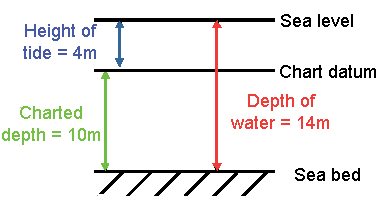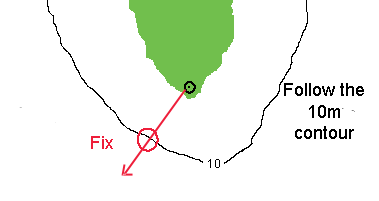Navigation and Chart work - A Position Line from the Depth
Position line from a depth
A fix using a bearing and depth can be very useful. It is not always very accurate but is often good enough. The bearing is plotted as before, but the depth must have some allowances made to it.
If the depth shown on the echosounder is 14.0m and height of the
tide is  known to be 4.0m, the charted depth must be 10.0m.
known to be 4.0m, the charted depth must be 10.0m.
You then look along the bearing you have already plotted on the chart until it crosses the 10.0m contour line.
Where they cross is your fix.
Alternatively you can follow a specific contour by positioning the vessel so the depth remains constant, then when you plot a  bearing taken with your handbearing compass or a transit you quickly know your position. This is particularly relevant when passing round a headland or danger area as the depth that is chosen should be well outside any hazards to the vessel.
bearing taken with your handbearing compass or a transit you quickly know your position. This is particularly relevant when passing round a headland or danger area as the depth that is chosen should be well outside any hazards to the vessel.
When the boat is moving, absolute accuracy is not always necessary, sometimes being able to put a position on the chart quickly is more important. This is nearly always the case if you are following a set of leading lights in to a harbour, sometimes at night it is very difficult to estimate how far you have to go before you arrive in the harbour, a quick check of the depth against the chart will frequently give you your distance off (allow for the height of the tide).
This method is only of use in an area with a gently shelving bottom. If it is very steep or undulating, it will not work well.
Question.
1. On Chart 2. A yacht observes the 2 F.G. 6M leading lights on North Coombe Island, in transit. If the depth is 35m, and the height of the tide is 5.0m, what is the yacht's position?
Can you see when the vessel's position will next be known with no further calculations?
Additional Resources:

